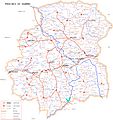Huambo Province facts for kids
Huambo is a large province in the country of Angola, located in southern Africa. It is home to about 1.9 million people. The main city and capital of the province is also called Huambo. This province is known for its rich farmlands. It produces more food than any other province in Angola.
Contents
Discovering Huambo Province
Huambo Province is in the central highlands of Angola. This means it has high land and mountains. The province is known for its beautiful natural areas. It has a cooler climate compared to other parts of Angola. This makes it great for growing crops.
Where is Huambo?
Huambo Province is right in the middle of Angola. It shares borders with several other provinces. These include Bié to the east and Benguela to the west. Its central location has always made it an important place for travel and trade.
What is the Climate Like?
The weather in Huambo is different from coastal areas. It has a tropical highland climate. This means it's not too hot. There are two main seasons: a rainy season and a dry season. The rain helps the plants and crops grow well.
History of Huambo
Huambo has a long and interesting history. It was once a very important railway hub. This helped connect different parts of Angola. The province has seen many changes over the years. It has grown into a key area for Angola's future.
Early Days and Growth
The city of Huambo was founded in 1912. It was first called Nova Lisboa, meaning "New Lisbon." It quickly became a major center. Its location made it perfect for trade and farming. The railway played a big part in its early growth.
Becoming a Province
Over time, Huambo grew in importance. It became a separate province. This helped it manage its own development. The people of Huambo have worked hard to rebuild and grow. They have focused on farming and education.
Economy and Agriculture
Huambo Province is often called the "breadbasket" of Angola. This is because it produces so much food. Its fertile land and good climate are perfect for farming. Agriculture is the most important part of its economy.
Main Crops Grown
Farmers in Huambo grow many different crops. Some of the most important ones are corn, beans, and potatoes. They also grow wheat, rice, and various fruits. These crops feed people across Angola. They also help the province earn money.
Beyond Farming
While farming is key, Huambo also has other activities. There are small businesses and markets. These help people buy and sell goods. The province is also working to improve its roads and services. This helps everyone in the community.
Culture and People
The people of Huambo Province are diverse. Many different ethnic groups live there. The Ovimbundu people are one of the largest groups. They have rich traditions and customs.
Daily Life in Huambo
Life in Huambo often revolves around farming and community. Children go to school. Families work together on farms. There are local markets where people gather. They sell fresh produce and handmade goods. Music and dance are also important parts of their culture.
Education and Future
Huambo is focused on educating its young people. There are schools and universities in the province. These places help students learn new skills. This prepares them for jobs in farming, technology, and other areas. Education is seen as a way to build a better future for everyone.
Interesting Places
Huambo Province has some beautiful natural sights. It also has important landmarks. These places show the history and beauty of the region.
Pedra do Alemão
One famous spot is the Pedra do Alemão. This means "German's Rock." It is a large rock formation. It offers amazing views of the surrounding landscape. It's a popular place for visitors to see the natural beauty of Huambo.
Huambo City
The capital city, Huambo, is a bustling center. It has markets, schools, and hospitals. It is also home to the Central University of Huambo. The city is a hub for trade and transportation. It connects the farming areas to other parts of Angola.
Images for kids
See also
 In Spanish: Provincia de Huambo para niños
In Spanish: Provincia de Huambo para niños



